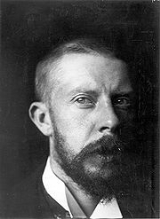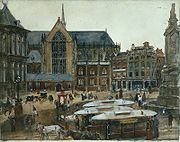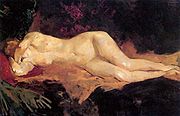
George Hendrik Breitner
Encyclopedia
George Hendrik Breitner (September 12, 1857 – June 5, 1923) was
a Dutch
painter
and photographer.
, Netherlands
. From 1876–1880 he attended the Academy in the Hague
where his extraordinary talent was rewarded on various occasions. From October 1878 till April 1879 he worked as an art teacher at the Leiden academy Ars Aemula Naturae. In 1880 he was expelled from the Art Academy of The Hague for misconduct, because he had destroyed the regulations-board. In the same year he lived at landscapist Willem Maris
's place at Loosduinen
and was accepted as a member of Pulchri Studio
, an important artist's society in The Hague.
From 1880-1881 he worked at the famous Panorama Mesdag
together with Hendrik Mesdag
, S. Mesdag-van Houten, Theophile de Bock and Barend Blommers.
In 1882 he met and worked together with Vincent van Gogh, with whom he often went sketching in the poorer areas of The Hague. Breitner preferred working-class models: labourers, servant girls and people from the lower class districts. Interest in the lot of the common people, which many artists felt in that period, was nurtured by the social conscience of French writers such as Emile Zola
.
He was a member of the Dutch artist group known as the Tachtigers (English
translation: "Eighty-ers"), because of their artistic influence in the years of 1880, including painters like Isaac Israëls
, Willem Witsen
, and poets like Willem Kloos
.
In 1886 he entered the Rijksacademie of Amsterdam, but soon it became clear that Breitner was far beyond the level of education offered there.
 Breitner saw himself as 'le peintre du peuple', the people's painter. He was the painter of city views par excellence: wooden foundation piles by the harbour, demolition work and construction sites in the old centre, horse trams
Breitner saw himself as 'le peintre du peuple', the people's painter. He was the painter of city views par excellence: wooden foundation piles by the harbour, demolition work and construction sites in the old centre, horse trams
on the Dam
, or canals in the rain. With his nervous brush strokes, he captured the dynamic street life. During the end of 1880, begin 1890, photo cameras where affordable, and now Breitner had a much better instrument to satisfy his ambitions. He became very interested in capturing movement and illumination in the city, and became a master in doing this. It is not impossible that Breitner's preference for cloudy weather conditions and a greyish and brownish palette resulted from certain limitations of the photographic material.
Breitner also painted female nudes, but just like Rembrandt he was criticized because his nudes were painted too realistically and did not resemble the common ideal of beauty. In his own time Breitner's paintings were admired by artists and art lovers, but often despised by the Dutch art critics for their raw and realistic nature.
 By the turn of the century Breitner was a famous painter in the Netherlands, as demonstrated by a highly successful retrospective exhibition at Arti et Amicitiae in Amsterdam (1901). Breitner travelled frequently in the last decades of his life, visiting Paris, London, and Berlin, among other cities, and continued to take photographs. In 1909 he went to the United States as a member of the jury for the Carnegie International Exhibition in Pittsburgh.
By the turn of the century Breitner was a famous painter in the Netherlands, as demonstrated by a highly successful retrospective exhibition at Arti et Amicitiae in Amsterdam (1901). Breitner travelled frequently in the last decades of his life, visiting Paris, London, and Berlin, among other cities, and continued to take photographs. In 1909 he went to the United States as a member of the jury for the Carnegie International Exhibition in Pittsburgh.
Although Breitner exhibited abroad early on, his fame never crossed the borders of the Netherlands. At the time foreign interest was more for anecdotal and picturesque works; the typical "Dutchness" of the Hague School
. As time went by critics lost interest in Breitner. The younger generation regarded impressionism
as too superficial. They aspired to a more elevated and spiritual form of art, but Breitner did not allow himself to be influenced by these new artistic trends. Around 1905-1910 pointillism
as practised by Jan Sluyters
, Piet Mondrian
and Leo Gestel
was flourishing. Between 1911 and 1914 all the latest art movements arrived in the Netherlands one after another including cubism
, futurism
and expressionism
. Breitner's role as contemporary historical painter was finished.
Breitner had only two pupils, Kees Maks
(1876–1967) and Marie Henrie Mackenzie (1878–1961).
He died on June 5, 1923 in Amsterdam
, Netherlands.
.jpg) Breitner introduced a realism
Breitner introduced a realism
to the Netherlands that created shock waves similar to that of Courbet
and Manet
's in France. In his early years, the corn merchant A.P. van Stolk, who was interested in art, played an influential role. He financially supported the young painter from 1877 to 1883, but his conservative taste clashed with Breitner's particular style.
The discovery in 1996 of a large collection of photographic prints and negatives made clear that Breitner was also a talented photographer of street life in the city. Sometimes he made various pictures of the same subject, from different perspectives or in different weather conditions. Photos sometimes formed the immediate example for a particular painting, for instance the girls in kimono. On other occasions, Breitner used photography for general reference, to capture an atmosphere, a light effect or the weather in the city at a particular moment.
Breitner is remembered in a Dutch figure of speech: when the streets are grey and rainy, people of Amsterdam whisper grimly "Echt Breitnerweer" (Typical Breitnerweather).
a Dutch
Netherlands
The Netherlands is a constituent country of the Kingdom of the Netherlands, located mainly in North-West Europe and with several islands in the Caribbean. Mainland Netherlands borders the North Sea to the north and west, Belgium to the south, and Germany to the east, and shares maritime borders...
painter
Painting
Painting is the practice of applying paint, pigment, color or other medium to a surface . The application of the medium is commonly applied to the base with a brush but other objects can be used. In art, the term painting describes both the act and the result of the action. However, painting is...
and photographer.
Biography
George Hendrik Breitner was born in RotterdamRotterdam
Rotterdam is the second-largest city in the Netherlands and one of the largest ports in the world. Starting as a dam on the Rotte river, Rotterdam has grown into a major international commercial centre...
, Netherlands
Netherlands
The Netherlands is a constituent country of the Kingdom of the Netherlands, located mainly in North-West Europe and with several islands in the Caribbean. Mainland Netherlands borders the North Sea to the north and west, Belgium to the south, and Germany to the east, and shares maritime borders...
. From 1876–1880 he attended the Academy in the Hague
The Hague
The Hague is the capital city of the province of South Holland in the Netherlands. With a population of 500,000 inhabitants , it is the third largest city of the Netherlands, after Amsterdam and Rotterdam...
where his extraordinary talent was rewarded on various occasions. From October 1878 till April 1879 he worked as an art teacher at the Leiden academy Ars Aemula Naturae. In 1880 he was expelled from the Art Academy of The Hague for misconduct, because he had destroyed the regulations-board. In the same year he lived at landscapist Willem Maris
Willem Maris
Willem Maris was a Dutch landscape painter of the Hague School.Willem was the third in a family of five children. His two brothers Jacob and Matthijs Maris preceded him as painters...
's place at Loosduinen
Loosduinen
Loosduinen is a former village in The Netherlands that was a municipality unto itself until 1923. At that time it merged with The Hague, and subsequently became known as the neighbourhood called Stadsdeel of that city.-References:...
and was accepted as a member of Pulchri Studio
Pulchri Studio
The Pulchri Studio is an important art institution and art studio based in The Hague, Netherlands. It began in 1847 at the home of painter Lambertus Hardenberg, established with the help of Johan Hendrik Weissenbruch, Jan Weissenbruch, Willem Roelofs, Jan Frederik van Deventer, Willem Antonie van...
, an important artist's society in The Hague.
From 1880-1881 he worked at the famous Panorama Mesdag
Panorama Mesdag
Panorama Mesdag is a panorama by Hendrik Willem Mesdag. Housed in a purpose-built museum in The Hague, the panorama is a cylindrical painting more than 14 metres high and about 40 metres in diameter...
together with Hendrik Mesdag
Hendrik Willem Mesdag
Hendrik Willem Mesdag was a Dutch marine painter.He was born in Groningen, the son of the banker Klaas Mesdag and his wife Johanna Wilhelmina van Giffen. Mesdag was encouraged by his father, an amateur painter, to study art...
, S. Mesdag-van Houten, Theophile de Bock and Barend Blommers.
In 1882 he met and worked together with Vincent van Gogh, with whom he often went sketching in the poorer areas of The Hague. Breitner preferred working-class models: labourers, servant girls and people from the lower class districts. Interest in the lot of the common people, which many artists felt in that period, was nurtured by the social conscience of French writers such as Emile Zola
Émile Zola
Émile François Zola was a French writer, the most important exemplar of the literary school of naturalism and an important contributor to the development of theatrical naturalism...
.
He was a member of the Dutch artist group known as the Tachtigers (English
English language
English is a West Germanic language that arose in the Anglo-Saxon kingdoms of England and spread into what was to become south-east Scotland under the influence of the Anglian medieval kingdom of Northumbria...
translation: "Eighty-ers"), because of their artistic influence in the years of 1880, including painters like Isaac Israëls
Isaac Israëls
Isaac Lazarus Israëls was a Dutch painter.The son of the painter Jozef Israëls, Isaac Israëls developed an interest in painting in childhood. Between 1878 and 1880 he studied at the academy in The Hague...
, Willem Witsen
Willem Witsen
Willem Witsen was a Dutch painter and photographer.Witsen was born in a wealthy ruling-class family, dating back to the governing families of the 17th century, of whom Cornelis Jan Witsen and his son Nicolaes Witsen were members. He studied at academies in Amsterdam and Antwerp...
, and poets like Willem Kloos
Willem Kloos
Willem Johannes Theodorus Kloos was a Dutch poet and literary critic, and is widely considered one of the great writers of the Dutch language....
.
In 1886 he entered the Rijksacademie of Amsterdam, but soon it became clear that Breitner was far beyond the level of education offered there.

Horsecar
A horsecar or horse-drawn tram is an animal-powered streetcar or tram.These early forms of public transport developed out of industrial haulage routes that had long been in existence, and from the omnibus routes that first ran on public streets in the 1820s, using the newly improved iron or steel...
on the Dam
Dam Square
Dam Square, or simply the Dam is a town square in Amsterdam, the capital of the Netherlands. Its notable buildings and frequent events make it one of the most well-known and important locations in the city.- Location and description :...
, or canals in the rain. With his nervous brush strokes, he captured the dynamic street life. During the end of 1880, begin 1890, photo cameras where affordable, and now Breitner had a much better instrument to satisfy his ambitions. He became very interested in capturing movement and illumination in the city, and became a master in doing this. It is not impossible that Breitner's preference for cloudy weather conditions and a greyish and brownish palette resulted from certain limitations of the photographic material.
Breitner also painted female nudes, but just like Rembrandt he was criticized because his nudes were painted too realistically and did not resemble the common ideal of beauty. In his own time Breitner's paintings were admired by artists and art lovers, but often despised by the Dutch art critics for their raw and realistic nature.

Although Breitner exhibited abroad early on, his fame never crossed the borders of the Netherlands. At the time foreign interest was more for anecdotal and picturesque works; the typical "Dutchness" of the Hague School
Hague School
The Hague School is the name given to a group of artists who lived and worked in The Hague between 1860 and 1890. Their work was heavily influenced by the realist painters of the French Barbizon school. The painters of the Hague school generally made use of relatively sombre colours, which is why...
. As time went by critics lost interest in Breitner. The younger generation regarded impressionism
Impressionism
Impressionism was a 19th-century art movement that originated with a group of Paris-based artists whose independent exhibitions brought them to prominence during the 1870s and 1880s...
as too superficial. They aspired to a more elevated and spiritual form of art, but Breitner did not allow himself to be influenced by these new artistic trends. Around 1905-1910 pointillism
Pointillism
Pointillism is a technique of painting in which small, distinct dots of pure color are applied in patterns to form an image. Georges Seurat developed the technique in 1886, branching from Impressionism. The term Pointillism was first coined by art critics in the late 1880s to ridicule the works...
as practised by Jan Sluyters
Jan Sluyters
Johannes Carolus Bernardus Sluijters was a Dutch painter.Sluijters was a leading pioneer of various post-impressionist movements in the Netherlands. He experimented with several styles, including fauvism and cubism, finally settling on a colorful expressionism...
, Piet Mondrian
Piet Mondrian
Pieter Cornelis "Piet" Mondriaan, after 1906 Mondrian , was a Dutch painter.He was an important contributor to the De Stijl art movement and group, which was founded by Theo van Doesburg. He evolved a non-representational form which he termed Neo-Plasticism...
and Leo Gestel
Leo Gestel
Leo Gestel was a Dutch painter. His father Willem Gestel was an artist, too. Leo Gestel experimented with cubism, expressionism, futurism and postimpressionism...
was flourishing. Between 1911 and 1914 all the latest art movements arrived in the Netherlands one after another including cubism
Cubism
Cubism was a 20th century avant-garde art movement, pioneered by Pablo Picasso and Georges Braque, that revolutionized European painting and sculpture, and inspired related movements in music, literature and architecture...
, futurism
Futurism (art)
Futurism was an artistic and social movement that originated in Italy in the early 20th century. It emphasized and glorified themes associated with contemporary concepts of the future, including speed, technology, youth and violence, and objects such as the car, the airplane and the industrial city...
and expressionism
Expressionism
Expressionism was a modernist movement, initially in poetry and painting, originating in Germany at the beginning of the 20th century. Its typical trait is to present the world solely from a subjective perspective, distorting it radically for emotional effect in order to evoke moods or ideas...
. Breitner's role as contemporary historical painter was finished.
Breitner had only two pupils, Kees Maks
Kees Maks
Kees Maks was a Dutch painter born in Amsterdam.He was a pupil of George Hendrik Breitner. While in the interbellum the avant-garde spread its influence through Europe, many artists returned to a neo-classical figuration, that became known as ‘Retour a l’ordre’...
(1876–1967) and Marie Henrie Mackenzie (1878–1961).
He died on June 5, 1923 in Amsterdam
Amsterdam
Amsterdam is the largest city and the capital of the Netherlands. The current position of Amsterdam as capital city of the Kingdom of the Netherlands is governed by the constitution of August 24, 1815 and its successors. Amsterdam has a population of 783,364 within city limits, an urban population...
, Netherlands.
Legacy
.jpg)
Realism (visual arts)
Realism in the visual arts is a style that depicts the actuality of what the eyes can see. The term is used in different senses in art history; it may mean the same as illusionism, the representation of subjects with visual mimesis or verisimilitude, or may mean an emphasis on the actuality of...
to the Netherlands that created shock waves similar to that of Courbet
Gustave Courbet
Jean Désiré Gustave Courbet was a French painter who led the Realist movement in 19th-century French painting. The Realist movement bridged the Romantic movement , with the Barbizon School and the Impressionists...
and Manet
Édouard Manet
Édouard Manet was a French painter. One of the first 19th-century artists to approach modern-life subjects, he was a pivotal figure in the transition from Realism to Impressionism....
's in France. In his early years, the corn merchant A.P. van Stolk, who was interested in art, played an influential role. He financially supported the young painter from 1877 to 1883, but his conservative taste clashed with Breitner's particular style.
The discovery in 1996 of a large collection of photographic prints and negatives made clear that Breitner was also a talented photographer of street life in the city. Sometimes he made various pictures of the same subject, from different perspectives or in different weather conditions. Photos sometimes formed the immediate example for a particular painting, for instance the girls in kimono. On other occasions, Breitner used photography for general reference, to capture an atmosphere, a light effect or the weather in the city at a particular moment.
Breitner is remembered in a Dutch figure of speech: when the streets are grey and rainy, people of Amsterdam whisper grimly "Echt Breitnerweer" (Typical Breitnerweather).

